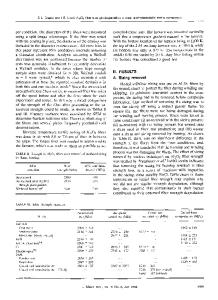The strength of metal matrix composites
- PDF / 867,943 Bytes
- 9 Pages / 597 x 774 pts Page_size
- 28 Downloads / 404 Views
I.
INTRODUCTION
AUTOMOTIVE components fabricated from metal matrix composites (MMCs) are already in mass production, led by the introduction of a diesel piston by Toyota in 1983 [11 and followed more recently by cylinder blocks from Honda. [2'31 In these initial applications, discontinuous (i.e., short) fibers are fabricated into a preform, then infiltrated with liquid metal under pressure. With this type of processing, the disposition of the fibers approximates a randomly oriented planar array, forming a composite with planar isotropic properties. The potential advantages of MMCs over conventional monolithic alloys are enhanced mechanical properties, particularly at elevated temperature. Improvement in modulus, strength, fatigue, creep, and wear resistance have already been demonstrated for a variety of reinforcements. [4.5.6] Of these properties, the tensile strength is the most convenient and widely quoted measurement and is of central importance in many applications. This article reviews the ultimate tensile strength (UTS) of an MMC reinforced with randomly oriented discontinuous fibers or whiskers. For this type of MMC, the literature contains conflicting reports. As will be illustrated in Section III, the strength of an alloy at room temperature may be increased substantially by the addition of fibers or it may be virtually unchanged. However, in the latter case, an increase in strength is often reported at elevated temperatures. In an attempt to understand this variety of results, we have adopted a procedure for calculating the UTS, using well-known micromechanics equations for continuous and discontinuous reinforcements. These calculations are compared with experimental data for graphite, SiC, and WILLIAM J. BAXTER, Senior Staff Research Scientist, is with the Physics Department, General Motors Research and Environmental Staff, Warren, MI 48090-9055. Manuscript submitted February 28, 1992. METALLURGICAL TRANSACTIONS A
A1203 reinforcements. Unfortunately, the investigations of graphite MMCs have been devoted almost entirely to aligned continuous fibers, while most studies of discontinuous SiC MMCs have been for extruded materials with highly aligned fibers, so we must rely primarily upon the extensive literature for SAFFIL* reinforcements. Our *SAFFIL is a trademark of ICI Americas, Inc., Wilmington, DE.
calculations rationalize the apparent conflicts and quantify the key role, in this type of composite, of the bond at the fiber/matrix interface. II. CALCULATION OF THE ULTIMATE TENSILE STRENGTH (UTS) There is no completely satisfactory method to calculate the strength of a composite reinforced with randomly oriented short fibers. The approach adopted here is first to consider the simpler case of a composite with aligned continuous fibers, for which the standard micromechanics analysis [61 is briefly reviewed below. The effect of fiber orientation on the strength is incorporated by adopting the Tsai-Hill (maximum work) failure criterion.J7] Then the effect of fiber length is accounted for by the shear lag
Data Loading...











